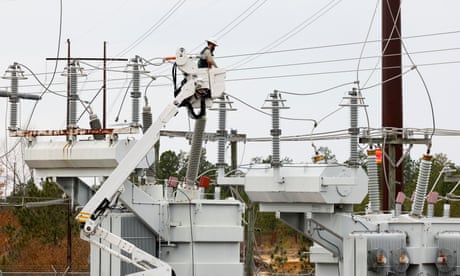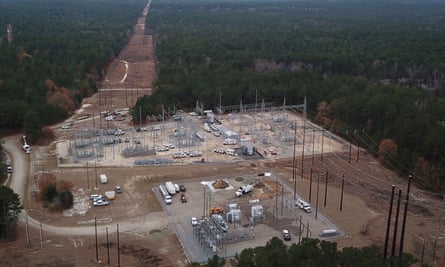Series of attacks come after assault on North Carolina facilities cut electricity to 40,000.
Power lines in Oregon, seen after a wildfire. It is unclear who is behind the attacks on power stations. Photograph: Mathieu Lewis-Rolland/Reuters
–
Last modified on 2022 Dec 10
–
A string of attacks on power facilities in Oregon and Washington has caused alarm and highlighted the vulnerabilities of the US electric grid.
The attacks in the Pacific northwest come just days after a similar assault on North Carolina power stations that cut electricity to 40,000 people.
As first reported by Oregon Public Broadcasting and KUOW Public Radio, there have been at least six attacks, some of which involved firearms and caused residents to lose power. Two of the attacks shared similarities with the incident in Moore county, North Carolina, where two stations were hit by gunfire. Authorities have not yet revealed a motive for the North Carolina attack.
The four Pacific north-west utilities whose equipment was attacked have said they are cooperating with the FBI. The agency has not yet confirmed if it is investigating the incidents.
It’s unknown who is behind the attacks but experts have long warned of discussion among extremists of disrupting the nation’s power grid.
Bonneville Power Administration (BPA) said in a statement on Thursday that it was seeking tips about “trespassing, vandalism and malicious damage of equipment” at a substation in Clackamas county on 24 November that caused damage and required cleanup costing hundreds of thousands of dollars.
“Someone clearly wanted to damage equipment and, possibly, cause a power outage,” said John Lahti, the utility’s transmission vice-president of field services. “We were fortunate to avoid any power supply disruption, which would have jeopardized public safety, increased financial damages and presented challenges to the community on a holiday.”
Any attack on electric infrastructure “potentially puts the safety of the public and our workers at risk”, said BPA, which delivers hydropower across the Pacific northwest .
Portland General Electric, a public utility that provides electricity to nearly half of the state’s population, said it had begun repairs after suffering “a deliberate physical attack on one of our substations” that also occurred in the Clackamas area in late November 2022. It said it was “actively cooperating” with the FBI.
Puget Sound Energy, an energy utility in Washington, reported two cases of vandalism at two substations in late November to the FBI and peer utilities, but said the incidents appeared to be unrelated to other recent attacks.
“There is no indication that these vandalism attempts indicate a greater risk to our operations and we have extensive measures to monitor, protect and minimize the risk to our equipment and infrastructure,” the company said in a statement.
–
Experts and intelligence analysts have long warned of both the vulnerability of the US power grid and talk among extremists about attacking the crucial infrastructure.
“It’s very vulnerable,” said Keith Taylor, a professor at the University of California, Davis, who has worked with energy utilities. “[These attacks] are a real threat.”
The physical risks to the power grid have been known for decades, Granger Morgan, an engineering professor at Carnegie Mellon University, told CBS. “We’ve made a bit of progress, but the system is still quite vulnerable,” he said.
A US Department of Homeland Security (DHS) report released in January warned that domestic extremists have been developing “credible, specific plans” to attack electricity infrastructure since at least 2020.
The DHS has cited a document shared on a Telegram channel used by extremists that included a white supremacist guide to attacking an electric grid with firearms, CNN reported.
“These fringe groups have been talking about this for a long time,” Taylor said. “I’m not at all surprised this happened – I’m surprised it’s taken this long.”
Three men who law enforcement identified as members of the Boogaloo movement allegedly planned to attack a substation in Nevada in 2020 to distract police and attempt to incite a riot.
In 2013, still unknown assailants cut fiber-optic phone lines and used a sniper to fire shots at a Pacific Gas & Electric substation near San José in what appeared to be a carefully planned attack that caused millions of dollars in damage. The attack prompted the Federal Energy Regulatory Commission (FERC) to order grid operators to increase security.
“They knew what they were doing. They had a specific objective. They wanted to knock out the substation,” Jon Wellinghoff, the then chair of FERC told 60 Minutes, adding that the attack could have “brought down all of Silicon Valley”.
After the 2013 attack in California, a FERC analysis found that attackers could cause a blackout coast-to-coast if they took out only nine of the 55,000 substations in the US.
The US electrical grid is vast and sprawling with 450,000 miles of transmission lines, 55,000 substations and 6,400 power plants. Power plants and substations are dispersed in every corner of the country, connected by transmission lines that transport electricity through farmland, forests and swamps. Attackers don’t necessarily have to get close to cause significant damage.
“In a centralized system, if I [want] to take out one coal fired plant, I don’t even have to take out the plant, I just have to take out the transmission line,” said Taylor. “You can cause a ripple effect where one outage can cause an entire seaboard to go down.”
The Associated Press contributed to this report
–
Topics
Most viewed
- –
- –
- –
- –


















